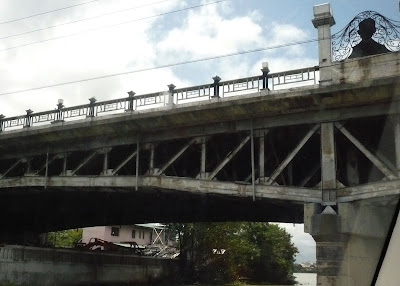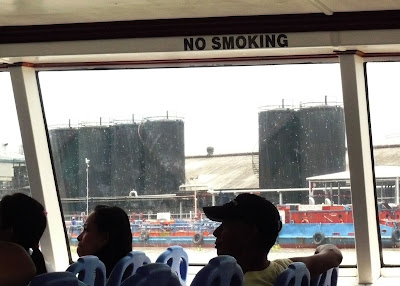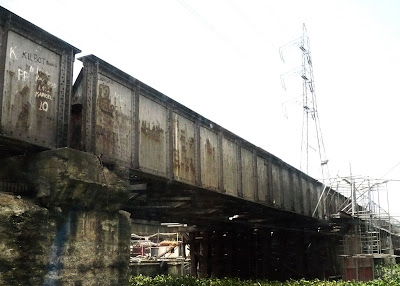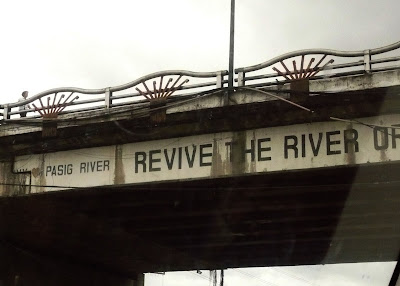
Part Two of our Pasig River Ferry coverage begins with the Nagtahan Bridge, still in the city of Manila. Nagtahan Bridge is the largest among all the bridges which crosses the river Pasig. It is also known as Mabini Bridge because it is quite near the Mabini House, which is inside the compound of the Presidential Security Group of the Malacañan Palace complex. This area of Manila is called Pandacan.
TRIVIA: The Pasig River is crossed by a number of bridges in the city of Manila alone. Eastward, they are the Roxas Bridge (commonly referred to as the Del Pan Bridge), Jones Bridge, McArthur Bridge, Quezon Bridge, Ayala Bridge, Nagtahan Bridge (also known as Mabini Bridge), Pandacan Bridge, and the Lambingan Bridge.
Outside the city of Manila, the following bridges cross the Pasig: Makati-Mandaluyong Bridge, Guadalupe Bridge, Carlos P. Garcia-C5 Bridge, Sixto Antonio-Bambang Bridge, Arsenio Jimenez-Kalawaan Bridge, and the C6 Bridge. Have you lost count already? :-)

Established in 1574 by Franciscan missionaries, Pandacan is widely known today as the place where major oil depots of the country are found. The name Pandacan came from the local pandan tree (Scientific name: Pandanus fascicularis Lam) grew abundantly along the banks of the river. It was originally designed to be Manila's industrial center hence the presence of refineries and factories in the area. Among notable national figures who hail from Pandacan is Apoliniario Mabini. It was home to Francisco Baltazar and Lope K. Santos. Imelda Marcos considered it her home in Manila pre-Malacañang days. Incidentally, portions of the Presidential Palace are actually in the Pandacan territory so I guess history has a way of playing with our lives and imagination.
It is also famous for its Cathlic church which honors the Sto. Niño de Pandacan.

The Polytechnic University of the Philippines (PUP) Station, the only school stop of the ferry service. Hyacinths hug the station from all sides. PUP is a state university located in Sta. Mesa. It was established in 1904 as the Manila Business School as part of the city school system. It was renamed as the Philippine School of Commerce and was merged with the Philippine Normal School from 1933 to 1946. By virtue of Republic Act 779, the PSC was again changed to Philippine College of Commerce in 1952 which subsequently was converted into a chartered state university now known as the Polytechnic University of the Philippines by virtue of Presidential Decree Number 1341 issued by the President of the Philippines on April 1, 1978. Whew! What a lot of name changes!

An old, rusty railway bridge. Pandacan was a major terminal stop for the 121-years old Philippine National Railways (c. 1887 as Ferrocarril de Manila-Dagupan; cornerstone laying of the Tutuban station). The line begins at Sta. Mesa and ends at Pandacan (not very long, isn't it?). I might have gotten my data wrong. Will update this portion later.

Residencias Manila, begun during the term of former Manila Mayor Lito Atienza. There are housing projects...

One of the houses has a streamer that reads, "Bahay mo, Ipaglaban mo!". This pretty much speaks of the continuing fight of the urban poor for a home of their own in this increasingly tight, busy, and dog-eat-dog world of Metro Manila.
The Lambingan Station marks the end of the Manila part of the route. Sta. Ana, where Lambingan is, is the border of the city with Makati.
Lambingan Bridge.














1 comment:
Hi Dylan,
I enjoyed looking at the pictures. I also hopped on a ferry ride last month, and the experience was really awesome. I am just praying that the city government of manila, or perhaps the owners of the magnificent buildings in front of Plaza Mexico, e.g. El Hogar Filipino, et. al, could help each other in renovating these beaux-art architectures.
Post a Comment